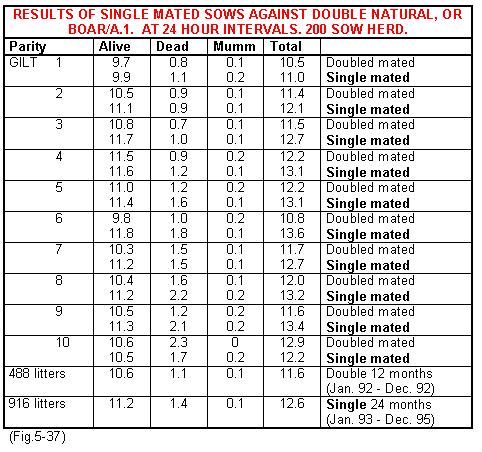



Single service (supervised)
Large computer data bases show that in most herds there is no difference in litter size or farrowing rate, whether the sow is single or multiple mated. If however records are analysed using conventional data, single services tend to show poorer litter size and farrowing rates. This is because a large proportion of single services take place in the sub fertile period i.e. weaning to service interval 7-14 days when litter size and pregnancy rates may be poor.
The advantages of single services
- Boars are only used once in 24 hours.
- Semen quality is excellent.
- Sows stand "rock hard". No continual trauma to the sow.
- The number of boars can be considerably reduced .
- There is a considerable reduction in management time.
- Extra accommodation is available.
- There is less capital cost in boars, or higher pointed boars can be purchased, thus improving performance of the progeny.
- In some herds it leads to an improvement in litter size and fertility.
- Boar usage can be facilitated by weaning half the litters one day leaving the sows in the crates and weaning the rest the next day. This will give a 24 hour gap between the two groups.
- Litter size may improve in gilts and second parity.
- There is less trauma to the reproductive tract and less likelihood of ascending womb infection.
Disadvantages of single service
- A boar may become infertile. However he will be detected earlier than with multiple matings. This is particularly so if cross mating is used, when an infertile boar may not be detected. It is uncommon for boars to be infertile. Test the semen regularly by drawing it into a syringe at service using a stomach tube placed by the cervix.
- In a few herds the results may be inferior.
- Assess the effects on farrowing rate.
- Sufficient boars must be held to allow for sudden illness or failure to work.
- The sow can be mated at the wrong time.
Procedures for single services
- Make sure the sow is fed to appetite on the day of weaning e.g. give 3/4 of the food 3 to 4 hours prior to movement from the farrowing quarters and the other 1/4 after movement.
- Feed the lactation diet ad lib to point of service.
- Only serve the sow when she is standing absolutely still i.e. only mate her when you have to almost lift her into the pen.
- Ensure the service is of good quality i.e. a good lock and long insemination.
- Never single mate if the weaning to service interval is s 7-14 day - i.e. the subfertile period. The time of standing oestrus in these sows is often 12 hours or less. Always mate them am/pm.
The common failure with single serving is to mate the sow too soon. If she is weaned on a Thursday the mating will usually take place on Tuesday morning. Sows on heat on the Monday will often have a long oestrus period and still stand to the boar on the Wednesday. Thus if mating occurs on Monday, sperm will have to wait until ovulation some 48-72 hours later. Their viability could be much reduced. Many farms now do not bother to heat check on the Monday even if multiple serving.
To assess the efficiency of single service in your herd mate 15% of sows for a period of 6 weeks and compare the results to the rest of the sows. Fig.5-37 shows the results of single services in a 200 sow herd for a 2 year period compared to a one year period of multiple matings. There was no change in farrowing rates at 87% but there was an increase in litter size.








